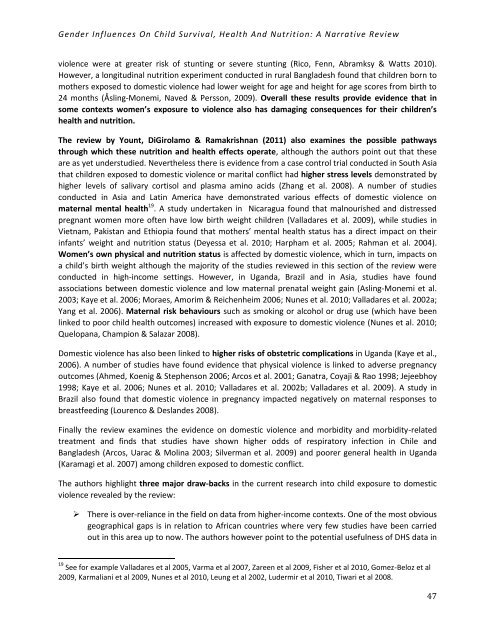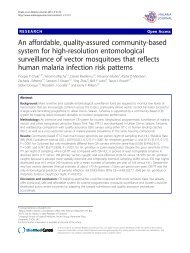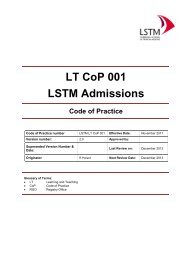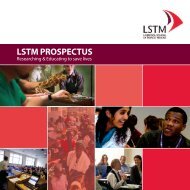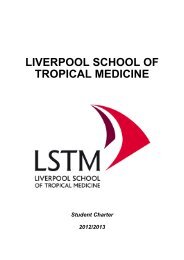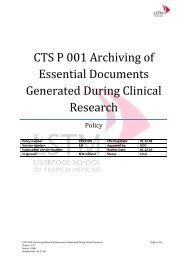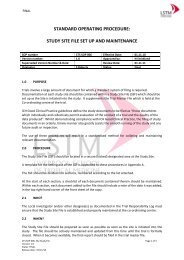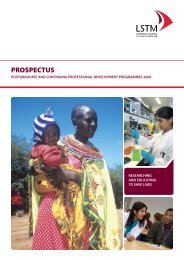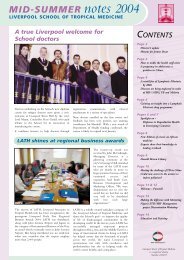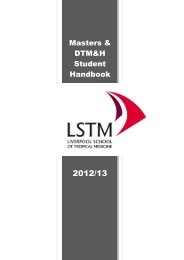Gender influences on child survival, health and nutrition: a ... - Unicef
Gender influences on child survival, health and nutrition: a ... - Unicef
Gender influences on child survival, health and nutrition: a ... - Unicef
You also want an ePaper? Increase the reach of your titles
YUMPU automatically turns print PDFs into web optimized ePapers that Google loves.
<str<strong>on</strong>g>Gender</str<strong>on</strong>g> Influences On Child Survival, Health And Nutriti<strong>on</strong>: A Narrative Review<br />
violence were at greater risk of stunting or severe stunting (Rico, Fenn, Abramksy & Watts 2010).<br />
However, a l<strong>on</strong>gitudinal nutriti<strong>on</strong> experiment c<strong>on</strong>ducted in rural Bangladesh found that <strong>child</strong>ren born to<br />
mothers exposed to domestic violence had lower weight for age <strong>and</strong> height for age scores from birth to<br />
24 m<strong>on</strong>ths (Åsling-M<strong>on</strong>emi, Naved & Perss<strong>on</strong>, 2009). Overall these results provide evidence that in<br />
some c<strong>on</strong>texts women’s exposure to violence also has damaging c<strong>on</strong>sequences for their <strong>child</strong>ren’s<br />
<strong>health</strong> <strong>and</strong> nutriti<strong>on</strong>.<br />
The review by Yount, DiGirolamo & Ramakrishnan (2011) also examines the possible pathways<br />
through which these nutriti<strong>on</strong> <strong>and</strong> <strong>health</strong> effects operate, although the authors point out that these<br />
are as yet understudied. Nevertheless there is evidence from a case c<strong>on</strong>trol trial c<strong>on</strong>ducted in South Asia<br />
that <strong>child</strong>ren exposed to domestic violence or marital c<strong>on</strong>flict had higher stress levels dem<strong>on</strong>strated by<br />
higher levels of salivary cortisol <strong>and</strong> plasma amino acids (Zhang et al. 2008). A number of studies<br />
c<strong>on</strong>ducted in Asia <strong>and</strong> Latin America have dem<strong>on</strong>strated various effects of domestic violence <strong>on</strong><br />
maternal mental <strong>health</strong> 19 . A study undertaken in Nicaragua found that malnourished <strong>and</strong> distressed<br />
pregnant women more often have low birth weight <strong>child</strong>ren (Valladares et al. 2009), while studies in<br />
Vietnam, Pakistan <strong>and</strong> Ethiopia found that mothers’ mental <strong>health</strong> status has a direct impact <strong>on</strong> their<br />
infants’ weight <strong>and</strong> nutriti<strong>on</strong> status (Deyessa et al. 2010; Harpham et al. 2005; Rahman et al. 2004).<br />
Women’s own physical <strong>and</strong> nutriti<strong>on</strong> status is affected by domestic violence, which in turn, impacts <strong>on</strong><br />
a <strong>child</strong>’s birth weight although the majority of the studies reviewed in this secti<strong>on</strong> of the review were<br />
c<strong>on</strong>ducted in high-income settings. However, in Ug<strong>and</strong>a, Brazil <strong>and</strong> in Asia, studies have found<br />
associati<strong>on</strong>s between domestic violence <strong>and</strong> low maternal prenatal weight gain (Asling-M<strong>on</strong>emi et al.<br />
2003; Kaye et al. 2006; Moraes, Amorim & Reichenheim 2006; Nunes et al. 2010; Valladares et al. 2002a;<br />
Yang et al. 2006). Maternal risk behaviours such as smoking or alcohol or drug use (which have been<br />
linked to poor <strong>child</strong> <strong>health</strong> outcomes) increased with exposure to domestic violence (Nunes et al. 2010;<br />
Quelopana, Champi<strong>on</strong> & Salazar 2008).<br />
Domestic violence has also been linked to higher risks of obstetric complicati<strong>on</strong>s in Ug<strong>and</strong>a (Kaye et al.,<br />
2006). A number of studies have found evidence that physical violence is linked to adverse pregnancy<br />
outcomes (Ahmed, Koenig & Stephens<strong>on</strong> 2006; Arcos et al. 2001; Ganatra, Coyaji & Rao 1998; Jejeebhoy<br />
1998; Kaye et al. 2006; Nunes et al. 2010; Valladares et al. 2002b; Valladares et al. 2009). A study in<br />
Brazil also found that domestic violence in pregnancy impacted negatively <strong>on</strong> maternal resp<strong>on</strong>ses to<br />
breastfeeding (Lourenco & Desl<strong>and</strong>es 2008).<br />
Finally the review examines the evidence <strong>on</strong> domestic violence <strong>and</strong> morbidity <strong>and</strong> morbidity-related<br />
treatment <strong>and</strong> finds that studies have shown higher odds of respiratory infecti<strong>on</strong> in Chile <strong>and</strong><br />
Bangladesh (Arcos, Uarac & Molina 2003; Silverman et al. 2009) <strong>and</strong> poorer general <strong>health</strong> in Ug<strong>and</strong>a<br />
(Karamagi et al. 2007) am<strong>on</strong>g <strong>child</strong>ren exposed to domestic c<strong>on</strong>flict.<br />
The authors highlight three major draw-backs in the current research into <strong>child</strong> exposure to domestic<br />
violence revealed by the review:<br />
‣ There is over-reliance in the field <strong>on</strong> data from higher-income c<strong>on</strong>texts. One of the most obvious<br />
geographical gaps is in relati<strong>on</strong> to African countries where very few studies have been carried<br />
out in this area up to now. The authors however point to the potential usefulness of DHS data in<br />
19 See for example Valladares et al 2005, Varma et al 2007, Zareen et al 2009, Fisher et al 2010, Gomez-Beloz et al<br />
2009, Karmaliani et al 2009, Nunes et al 2010, Leung et al 2002, Ludermir et al 2010, Tiwari et al 2008.<br />
47


